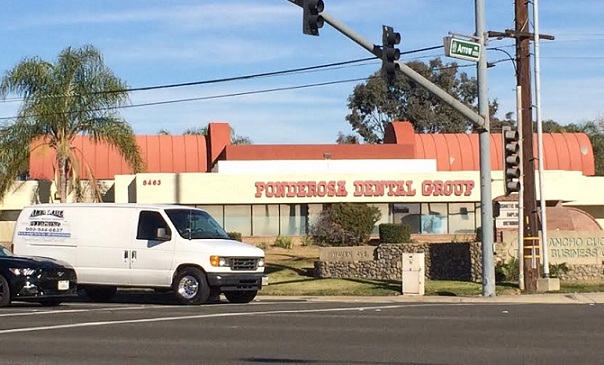[As I’ve said, in this series I tried to touch on a wide swath of Pomona, including ethnicities. Thus, I was pleased to devote the letter P to an obscure but long-lived church serving the black community. This column was originally published Dec. 12, 2004. Bear that in mind for a couple of references below to “today,” which is long past.]
P is for Primm, Pomona’s small but proud church
Things have come to a pretty pass with “Pomona A to Z,” which picks up with the letter P.
Among Pomona’s plethora of P possibilities:
* Pan dulce at panaderias, the Mexican bakeries that are plentiful in Pomona.
* Phillips Mansion, the 1875 home of pioneer Louis Phillips, whose name graces Phillips Ranch and Phillips Boulevard.
* Presidential streets Lincoln, Roosevelt, McKinley, Madison, Adams, Jefferson, Garfield, Monroe and Buchanan.
* Porpoise statue depicted in mid-dive in an East Second Street fountain, installed as part of 1962’s Pedestrian Mall.
* Picture postcards by Pomona photographer Burton Frasher Sr. (1888-1955). The Pomona Library has 5,000 of them, many viewable online at http://content.ci.pomona.ca.us./index.html
* Pomona College, which held its first classes at White and Mission in 1888 before moving to Claremont — without changing its name — the next year. For entertainment value, it’s hard to beat the plaque affixed to a rock that marks the historic college’s birthplace, which is now Angelo’s Burgers.
Which P to pick? What a pickle! But our P is yet another peak: Primm Tabernacle AME Church.
Primm is no Pilgrim Congregational or First Baptist, the stately churches that consume entire city blocks in the heart of town, grand reminders of the days when Pomona was dubbed “City of Churches.”
Primm is a modest complex along South Garey Avenue. Yet it has a history as noteworthy as its wealthier brethren.
The valley’s first black church, it was pastored in the 1960s by the Rev. Cecil M. “Chip” Murray, who went on to become the best-known minister in Los Angeles.
The history is long, too. In fact, Primm is getting older all the time.
Its 40th anniversary fell in 1948, its 100th in 1998 and its 108th just six years later — today, as a matter of fact.
No, time isn’t speeding up. Historians keep changing their mind on when the church started. More on this in a minute.
Today’s service is planned for 10 a.m., followed by a ceremony and a soul food lunch.
Here’s a capsule of milestones. Pomona’s First AME — affiliated with the African Methodist Episcopal denomination — built a small church in 1908 at 10th and Thomas. The church adopted the Primm name in 1961, naming itself after an AME bishop, and moved to its current, larger quarters, a former Mormon church, in 1977.
The 1908 church still stands today as the home of a Baptist congregation. About the size of an apartment, the simple wooden building has been covered in gray stucco.
Next door is a small parsonage, and behind it is — historians take note — the original outhouse, used by Primm members until the 1977 move.
On a recent visit, two longtime church members reflected on the old days there.
Johnnie Williams, a member since 1963, remembers trying to sneak out of church early one day without the minister catching her. She was busted, she recalled with a laugh, when she left her Bible in the privy and had to go back for it.
Dorothy Heard joined the church in 1975. Despite a lifetime of churchgoing, Primm is where she finally felt saved.
“The place was small. Everybody had to sit close. We had to be close whether we wanted to or not,” Heard said. “I miss this little church in a way.”
Exactly when the little church began is hard to pin down. Records are sketchy, and newspapers virtually ignored the black church, as one might expect of that era.
City directories have surfaced with listings for “Methodist Church, African, corner Third and Olive” as far back as 1896, thus accounting for the 108th anniversary celebration today, event co-chairwoman Eleanor Duncan told me.
Who knows — with more research, the 110th anniversary could be next month.
There’s no other information before 1909, but it’s safe to conclude the church had just a handful of members, most of whom were probably citrus workers, domestics or janitors like other blacks of the day.
The church seems to have suffered shifting fortunes. Listings fell in and out of city directories over the first half of the 20th century, and a brief notice from 1947 in the Progress-Bulletin said the church was set to reopen.
Pomona’s black population exploded in the 1960s, going from 800 in 1960 to 10,000 in 1970, setting the stage for the church’s resurgence.
The Rev. Murray served in that era. He retired in fall 2004 as pastor of L.A.’s First AME, which he built from a small congregation to a must-stop for Democratic politicians.
Duncan and Williams are among those who remember Murray’s 1964 to 1966 Pomona tenure, immediately after finishing his studies at the Claremont School of Theology.
“We were the first church he ever pastored,” Duncan said. “In fact, he baptized my daughter (Eva), who’s now an AME pastor. She was his first baptism.”
(David Allen writes Sunday, Wednesday and Friday, his particular pattern.)

